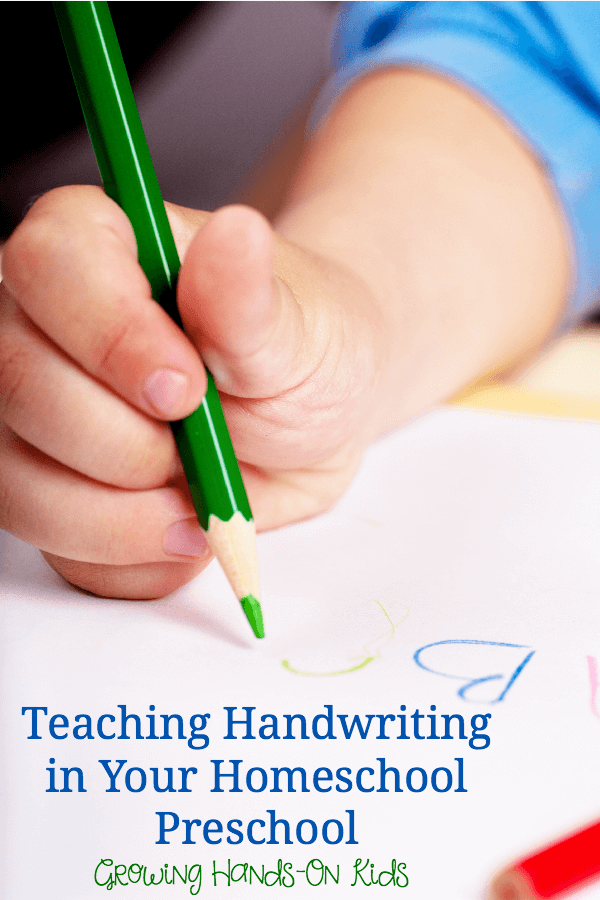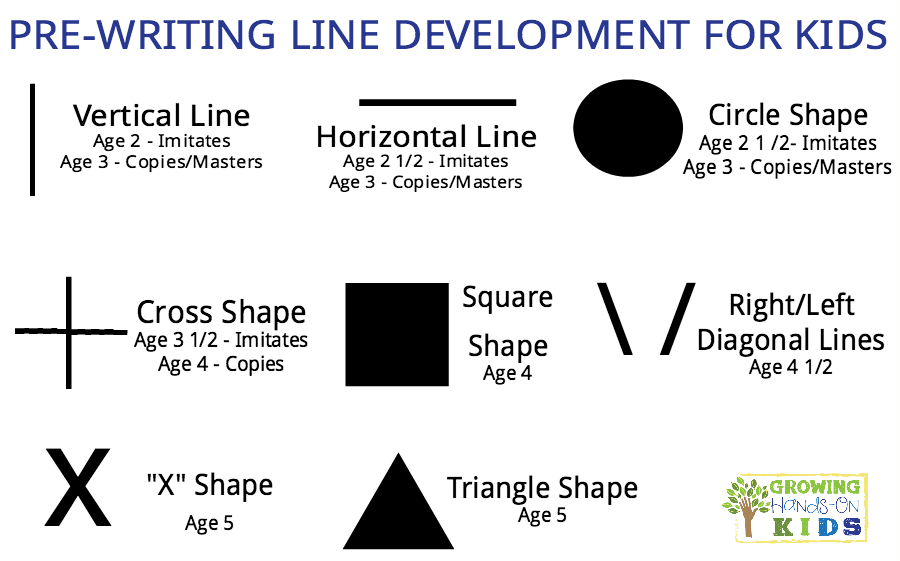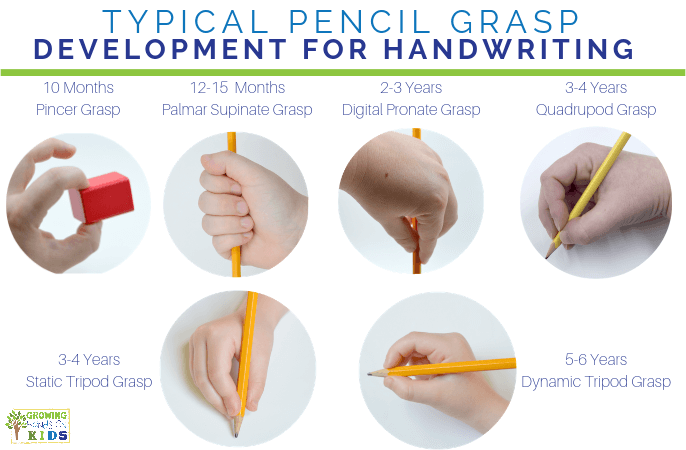Teaching Handwriting in Your Homeschool Preschool
Affiliate and Referral links are used below to promote products I love and recommend. I receive a commission on any purchases made through these links. Please see my disclosure policy for more details. As an Amazon Associate, I earn from qualifying purchases.
I am often asked about handwriting and fine motor skills from other moms, in particular homeschooling moms. Handwriting can be a daunting subject to teach much like reading may be for some (or in my case, Math).
Understanding that handwriting is more than just how to hold a pencil or print neatly will help you in teaching handwriting in your homeschool.
As a Certified Occupational Therapy Assistant, I worked with handwriting issues a lot when I was in the public school setting. I have since come to stay at home with my daughter, but giving parents resources and education on handwriting has become a passion of mine. If you have been around the blog for a little while, you will see that I write about handwriting and fine motor skills a lot.
Teaching Handwriting in Preschool
Today we are going to tackle how to start teaching handwriting to your preschool age child. Preschool age is typically between 3-5 years old. This may shock you, but the best way to teach your preschool age child how to write is to give them anything but a regular pencil and paper to write with.
Handwriting really begins at a much earlier age than preschool even. Babies, at just a few months old, are beginning to develop the hand strength, eye tracking, coordination, and trunk and arm strength needed for handwriting.
Tummy time gives your child the opportunity to coordinate their arms in order to lift their head off the ground. When they lift their head up off the ground, they are able to visually get a sense of their surroundings and begin to explore. Their head is put into different positions (vestibular input = balance) and their joints are getting proprioceptive input (knowing where their body is in space) when they push into the floor. The entire time they are developing strong neck muscles and integrating reflexes which help them to develop finer gross motor and fine motor skills, just from being on their stomachs.
Crawling not only helps babies to coordinate both sides of their bodies together (bilateral coordination), it also helps to improve their visual-motor skills (looking down at their hands and then lifting their neck to see the object they are after).
Crawling also helps to develop the neck, arm, and trunk muscles. A strong core or trunk gives them a stable base of support. Not only does this affect their gross motor skills later on in life (such as kicking, jumping, etc) it also affects their fine motor skills and handwriting.
Picture this… you have a child in 1st or 2nd grade. Their handwriting is very poor. They cannot keep the letters on the line; they can't form the letters correctly; spacing sentences and letters is non-existent or very poor. And getting them to sit still long enough to even complete a short writing task is a problem.
There could be more issues going on, which is why it is always best to talk to your physician and ask for an Occupational Therapy referral to be sure.
However, if they have poor trunk support, weak neck muscles, and their shoulders tire easily, then they will not be able to sit and do handwriting like you want them to. This leads to weak hand muscles which affect how they hold a pencil.
By not getting good visual-motor skills from not enough tummy time or crawling, affects how they write their letters, how they hold their pencil, how the entire process of writing works for them.
So what can you do to ensure your preschooler has excellent pre-writing skills in order to have great handwriting later on? By letting them explore the world around them with as much movement as possible.
Even older children can do crawling games, lay on their stomachs to play a board game or watch a movie, move and jump and swing in as many different positions as possible. Exposure to pre-writing lines and skills is key as well. It starts by understanding the basic development of fine motor skills.
After you feel you have a good understanding of what your child developmentally can do then you can base your activities and homeschool around those milestones. That is why I actually developed my first ebook, Basic Shapes for Beginners. It is a hands-on approach to teaching handwriting for preschoolers. Pre-writing lines or strokes are the precursors to handwriting. They also develop in a specific, age-appropriate pattern:
- Vertical Lines– (Age 2 imitates, age 3 copies/masters)
- Horizontal Lines – (Age 2 imitates, age 3 copies/masters)
- Circle shape – (Age 2, age 3 copies/masters)
- Cross shape (+) – (Age 3 imitates, age 4 copies)
- Right/Left Diagonal Line – (Age 4)
- Square shape– (Age 4)
- X shape – (Age 4)
- Triangle shape (Age 5)
Basic Shapes for Beginners takes each of these shapes and lines and gives you a 6 week lesson plan, complete with 30+ hands on activities to expose your child to the pre-writing lines and shapes they need for handwriting skills later on in their schooling.
Pencil Grip & Teaching Handwriting to Preschoolers
Break their crayons in half – Yes, I realize I probably just upset a lot of you right now. But yes, take those brand new crayons and break them in half! By giving your child a small crayon to practice tracing or pre-writing lines with, you are basically forcing them to use a correct grasp.
By age 3-4, your child should be developing a correct tripod (3 finger grasp) or quadruped grasp (4 finger grasp).
If your child wants to use a pencil, getting small golf size pencils are ideal. However, you can also just sharpen a regular pencil down halfway and get the same effect. The larger the writing utensil, the more room they have to put more fingers on the pencil than they should or use an inefficient grasp. This is also a good idea for older children who are having trouble with pencil grasp.
- Pencil Grasp Development – step by step developmental progression of hand grasp (complete with pictures)
I also need to stop here for a second and tell you that those large jumbo size crayons that are said to be made just for your preschooler…. ignore them! Stick with the regular size crayons or the regular size triangle type crayons (these are particularly helpful if you have a child who has trouble keeping their fingers on a crayon or pencil).
The large jumbo size crayons may seem like they are easier for your child to hold, but instead, they are putting too much space between their index and thumb fingers. These crayons actually promote bad hand grasp on writing utensils later on.
Here are some more resources for you on handwriting and including fine motor skills in your homeschool:
Other activity ideas and resources for teaching handwriting to preschoolers – All of these are hands-on activities:
- Play Dough Alphabet Letters – Teachers of Good Things
- Alphabet Stamping – Teachers of Good Things
- 5 Effective Ways to Teach Handwriting to Preschoolers – This Reading Mama
- Handwriting Practice Your Preschooler Will Love – The Measured Mom
- Writing with Beads and Pipe Cleaners – Here Come the Girls
- Fine Motor Activities for Improving Pencil Grasp – Sugar Aunts
- Cotton Swab Painting – Lessons Learned Journal
- Tips for Correct Pencil Grip – This Reading Mama
Follow Heather @ Golden Reflections Blog's board Handwriting Skills & Activities on Pinterest.
Follow Heather @ Golden Reflections Blog's board Fine Motor Skills Prek & Up on Pinterest.
You can also find the rest of the posts in this series as they are written here:

Heather Greutman, COTA
Heather Greutman is a Certified Occupational Therapy Assistant with experience in school-based OT services for preschool through high school. She uses her background to share child development tips, tools, and strategies for parents, educators, and therapists. She is the author of many ebooks including The Basics of Fine Motor Skills, and Basics of Pre-Writing Skills, and co-author of Sensory Processing Explained: A Handbook for Parents and Educators.




In my country and in our schools the teachers don’t even have ideas about these pre writing fine motor skills. At age 3 students are given pencils directly and asked to write alphabet and numbers. I hope to use your article as reference. I cannot make my colleagues understand that learning should be fun for 3to5 years old kids.
What a well researched and written post. Thanks for all the tips. Pinned!
Thank you Monica!
Very informative! My DD is only 7 months old, but your section on crawling hit home. We are just starting to watch our DD TRY to start crawling. She’s not there yet. She’s never been a big fan of tummy time, but we know it’s so critical to her development. But didn’t dawn on me it could influence her handwriting! Awesome! Thanks for sharing.
Katie @ Cup of Tea blog
Great post! And so much more than just beginning handwriting skills!
I’m so glad I found you. I want to home school my daughter but have no idea where or how to start. I opted to send her to preschool in the meantime so I can figure things out. I’m encouraged by the resources you offer. I may be able to do it sooner than I thought. Pinned 🙂
Hi Marisela,
So glad you came by!! If you ever have any questions don’t hesitate to ask! Good luck on your homeschool journey! It is definitely possible at any age!! Blessing to you!